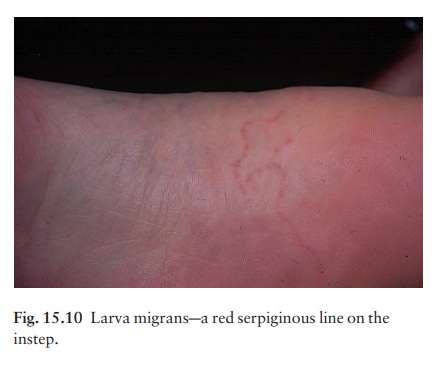Chapter: Clinical Dermatology: Infestations
Infestations of Parasitic worms
Parasitic
worms
A
textbook of tropical medicine should be consulted for more details on this
subject.
Onchocerciasis
This
is endemic in much of Central America and Africa where it is an important cause
of blindness. The buffalo gnat (Simulium species) carries the filarial worm
to humans. Infested humans become itchy with an excoriated papular eruption.
Later the skin may thicken and become hyper- or hypopigmented. Dermal nodules
are found, mainly near bony prominences, and contain both mature worms and
microfilariae. It is the latter that invade the eye, leading to blindness. The
diagnosis is confirmed by detecting active micro-filariae in skin snips teased
out in saline and examined microscopically. Ivermectin is now the treatment of
choice. A single dose produces a prolonged reduction of microfilarial levels,
and should be repeated every year until the adult worms die out.
Diethylcarbamazine and suramin are now obsolete.
Filariasis
This
is endemic throughout much of the tropics. The adult filarial worms, usually Wuchereria
bancrofti, inhabit the lymphatics where they excite an inflam-matory
reaction with episodes of lymphangitis and fever, gradually leading to
lymphatic obstruction and lymphoedema, usually of the legs or scrotum. Such
swellings can be massive (elephantiasis). There is an eosinophilia and
microfilariae are found in the peripheral blood, mainly at night; their vector
from human to human is the mosquito, in which the larvae mature.
Diethylcarbamazine or ivermectin is the treatment of choice.
Larva migrans
The
larvae of hookworms that go through their full life cycle only in cats or dogs
can penetrate human skin when it is in contact with soil or sand contamin-ated
by the faeces of these animals. The larvae move under the skin creating
tortuous red itchy lines (Fig. 15.10) that advance at the rate of a few
millimetres a day. The larvae do eventually die, but this can be speeded up by
a single oral dose of ivermectin.

Other worm infestations
•
Threadworm (pinworm) infestation in
children can cause severe anal and vulval pruritus. The small worms are seen
best at night-time when the itch is worst. Treatment is with piperazine.
•
Swimmer’s itch, in tropical and lake
waters, may be caused by the penetration through the skin of the cercariae of
schistosomes of human and non-human origin. The skin should be towelled off
immediately
after
swimming to prevent the schistosomes penetrat-ing the skin as it dries.
•
The larval stages of the pork
tapeworm (cysticer-cosis) can present as multiple firm nodules in the skin.
•
Larger fluctuant cysts may be caused
by hydatid disease.
Related Topics